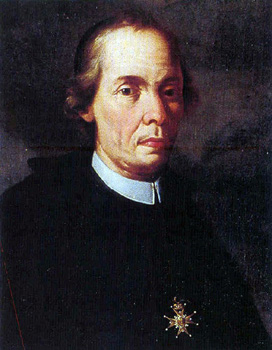|
“Building without
offending proper decorum” |

Protrait fo Pérez Bayer, University of Valencia,
assembly hall |
|
When the San Carlos Royal Academy of Fine Arts was
established in the angle formed by Salvá and la
Universidad streets in 1765 the facilites were
remodelled by the architect Vicente Gascó and the façade
was brought into line. Shortly afterwards, the need to
adapt the building to the new demands of enlightened
reformism required different works. In 1788 a
neighbouring house and munitions furnace in la
Universidad street were purchased to build more lecture
rooms, according to plans designed by Antonio Perales.
But a chemical laboratory and an astronomical
observatory above it, commissioned in 1790 by the rector
Blasco to José Pérez, were not materialized.
The most important construction of the period was
undoubtedly the library, for which new land was bought
on the corner of la Universidad and la Nave streets. The
plan was designed in 1789 by Joaquín Martínez, one of
the most significant architects of Valencian
neoclassicism. The plain and sober construction followed
the monumental style of the Enlightenment for public
buildings, and was not finished until 1795. There were
six spacious lecture rooms on the ground floor and the
main floor, “a large and magnificent hall”, was occupied
by the splendid donation made by the scholar and
bibliophile Francisco Pérez Bayer, who had promised “to
fill it with exquisite books and other curiosities”.
It was presided over by a bust of Bayer himself on a
jasper and bronze pedestal by José Esteve. At the
beginning of 1812 Valencia was bombarded during the
siege by Napoleon’s troops under Marshall Suchet,
causing the destruction of a large part of the
university building. On January 7 the library was burnt
down and the books were reduced to ashes. As the fire
grew stronger, “professors, students and workers
struggled to save whatever they could” (Fernando Llorca). |